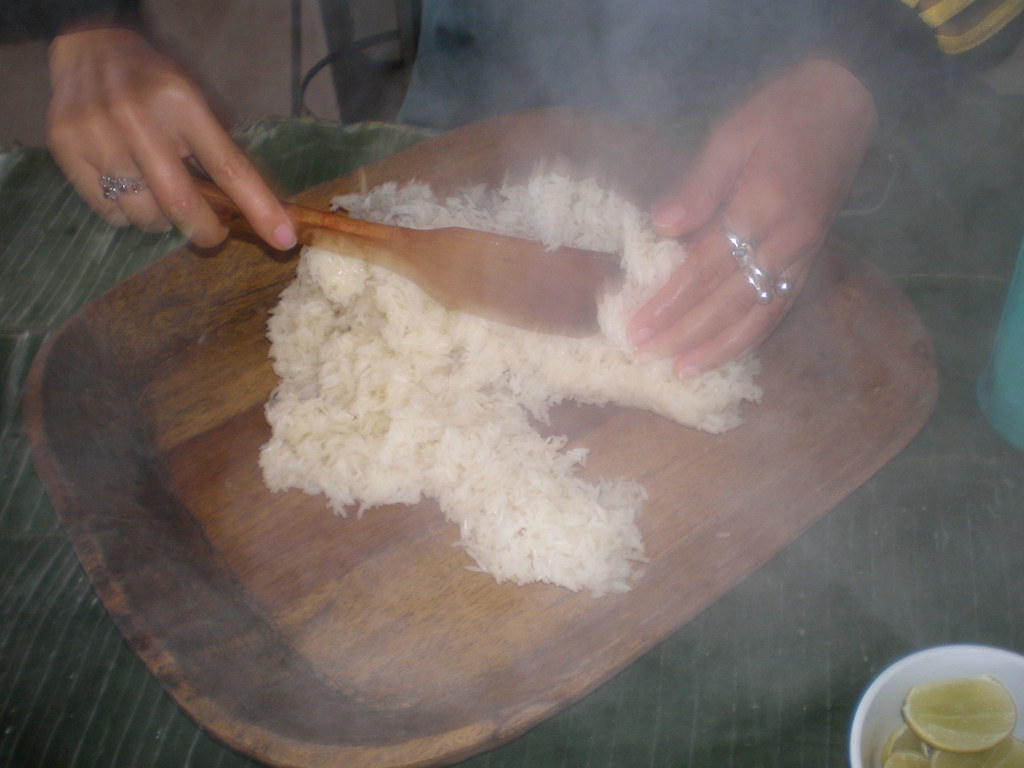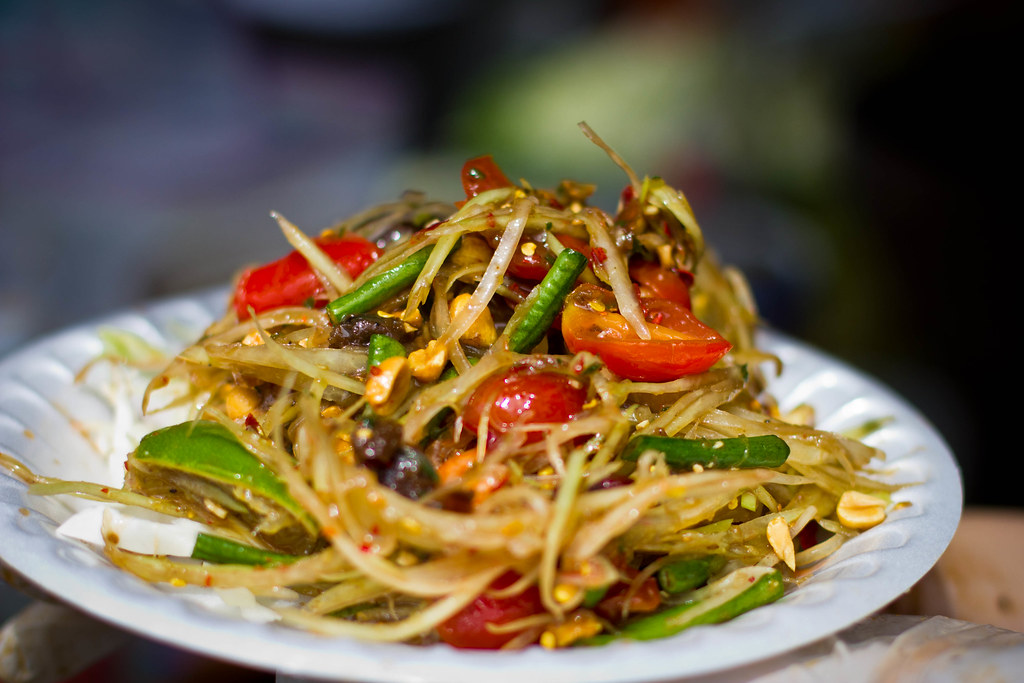
The ubiquitous “khao neow” (sticky rice) is the staple food of Laos and is eaten during most meals. Nearly all dishes are eaten with khao neow, which is traditionally eaten with the hands/fingers. After the rice has been cooked/steamed, it is folded and mixed together, at the same time being cooled/aerated, before it is placed into the serving rice baskets, ready for eating.
[dropcap]Lao[/dropcap] food/Lao cuisine (“aharn Lao” or khao Lao”) has received considerable interest and recognition across the world in recent years, Australia included. The coverage of Lao food on Lao Food Safari and Luke Nguyen’s Greater Mekong, not only helped put Lao food on the map, but also celebrate the diversity and richness of Lao cuisine. Even so, the big picture of Lao food remains a mystery to many people, including some Lao people, like myself.
Real Lao food is not easy to find and Lao restaurants are still few and far between. Beyond the surface, there’s more to Lao food than “larb”, “tum mark hoong” and “khao neow”, and the more I search, the more I realise that there’s an art and charm to Lao cuisine.
Across the world, Lao food in its many incarnations remain an exotic cuisine, but the tables are quickly turning. Lao food is gaining more likes and fans, and becoming a force to be reckoned with in the modern culinary scene. In this (two part) post, I would like to share some of my research and observations on Lao food today.
What is Lao food?
The delicious cuisine of Laos is unique in character and rich in variety. 1 It is sometimes compared to the food of Northern Thailand, Isan and Vietnam, and although it shares similar dishes with these regions, traditional Lao food is distinctly different and diverse.
Historically, Lao food is influenced by cooking traditions from the north (which is now part of China). Neigbouring regions (including regions of Thailand and Vietnam) have also influenced Lao cuisine, and vice versa – resulting in melting pot regions in Isan, Cambodia and Lanna. French colonial influence is also evident in some of the modern food found in Vientiane and Luang Prabang. 2
For a small country, Laos is culturally rich – comprising of many ethnic groups, resulting in unique regional dishes, as well as variations of “national” dishes. Being land-locked and bordered by the Mekong River and lush forests; river and forest produce are important ingredients in many Lao dishes. Lao meals are often prepared from scratch with fresh ingredients that are sourced from subsistence farming or fresh produce markets.

“Larb”, (usually a meat or fish dish prepared similar to ceviche and tartare) is regarded as the national dish of Laos. Larb is a popular dish in Laos and abroad, eaten with “khao neow” and accompanied with fresh herbs and vegetables. The meat can be prepared/served raw or cooked.

“Tum mark hoong” (spicy green papaya salad) is a classic traditional Lao dish that is popular across the world. The use of “padaek” in the dish stamps it Lao.

“Jeow” (Lao relish/condiment/dip) are traditionally served with Lao meals and there’s a myriad of types and variations. “Jeow bong” is a delicious and spicy specialty jeow of Luang Prabang and is made from grilled herbs, spices and slices of water buffalo skin.
Lao food is sometimes described as rustic, earthy, peasant and simple, with flavours that are pungent, fiery, herbal, bitter, astringent, etc. Lao dishes are distinct to its neighbours in several ways, for example; savoury dishes are usually not sweet, and bitter ingredients are often incorporated in dishes including salads and soups.
There is a Lao saying – “van pen lom, khom pen ya,” which translates to “sweet makes you dizzy, bitter makes you healthy”. This saying not only reflects the Lao’s preference for bitter flavours but also their view on food as having healing properties. 3
Laos has the highest per-capita sticky rice consumption in the world. 4 Sticky rice, known in Lao as “khao neow” is the staple food of Laos and is considered the essence of what it means to be “Lao”, with Lao people sometimes referring themselves as “look khao neow” (children of sticky rice).
“Padaek” (pungent traditional Lao fermented fish sauce/condiment) is a quintessential Lao ingredient and is used extensively in the preparation of many traditional Lao dishes including “larb”, “tum mark hoong”, “jeow”, etc.
“Larb” (spicy minced fish/meat salad prepared similar to ceviche and tartare) is regarded as the national dish of Laos. It is enjoyed across the country, and there are many variations in neigbouring regions and across the world.
“Tum mark hoong” (spicy green papaya salad) is another popular Lao dish with many variations, and it is often served at most Lao meals with accompaniments including grilled chicken, dried fish/beef and fresh vegetables, etc.
Other celebrated Lao dishes include “khao piak sen”, “nam khao”, “jeow bong”, “gaeng nor mai”, “mok pa”, etc – the list goes on. 5
Traditionally, Lao food is eaten with “khao neow”, and with the hands/fingers. A portion of a dish is picked up with a pressed/flattened ball of rice and then eaten. Naturally, soups and noodles are eaten with spoons and chopsticks.
Another distinctive tradition is the use of a “ka toke” (round woven bamboo serving platform) to arrange/serve food on. The “prepared” ka toke is customarily placed on the floor where the meal is served and shared with family and friends. In modern homes, the ka toke is often replaced with the dining table, however, the custom is still upheld at temples when monks are served their meals.
A traditional Lao meal typically consists of a soup dish, a grilled meat dish (fish, beef, ox tongue, etc), sauces (“jeow”), a plate of herbs and vegetables (fresh and/or steamed), and a stew or mixed dish (“goy”,”larb”, “mok”, “khua”, etc), and of course a woven bamboo basket of steaming hot “khao neow”. 6
~
Continue Reading: What is Lao food? Part 2
Notes:
- Ok, I admit it, I’m biased about Lao food but for the right reasons. If you ask anyone (Lao or non-Lao) who has eaten Lao food before, they will tell you that Lao food is extremely delicious and well worth the effort to find and taste! ↩
- Reference: http://en.wikipedia.org/wiki/Lao_cuisine. ↩
- Reference: http://en.wikipedia.org. ↩
- Reference: http://www.smithsonianmag.com. ↩
- For a list of more Lao dishes, go to : http://en.wikipedia.org. ↩
- Reference: http://en.wikipedia.org. ↩
There are a couple of Laotian restaurants that we’ve visited. The food is great and I always enjoy dining at them:)
Hi Lorraine, There’s a growing number of Lao restaurants in Sydney, although they’re still difficult to find. Some Thai and Isan restaurants also serve some Lao dishes. There are more Lao restaurants in the western suburbs, including Cabramatta and Fairfield. Glad to know you enjoyed your Lao meals.
Lao cuisine isn’t something I’m terribly familiar with but I’m in love with your papaya salad – looks amazing and what a great image xx
Thanks for your comment hotlyspiced! Lao cuisine is still a mystery in Sydney and Australia and I hope to share more Lao food stories and recipes with you. If you’re referring to the papaya salad in this post, unfortunately it’s not my photo, although I wished I had made it and taken the photo too. If you referring to the papaya salad here, thanks very much. I appreciate it!
I love the new look and love this summary, really helpful!
Thanks Thang for your lovely comment. I really appreciate it.